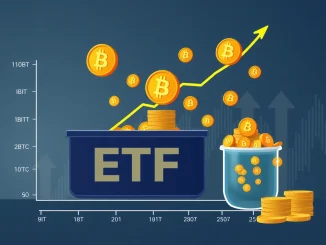
In the rollercoaster world of finance, where markets often swing wildly with every economic tremor, one digital asset has been quietly flexing its muscles – Bitcoin. While traditional equities have been feeling the heat of recent market anxieties, particularly those sparked by U.S. tariff tensions, Bitcoin (BTC) has shown remarkable resilience. According to a recent analysis by Bernstein, Bitcoin has only dipped by 10% year-to-date, a far cry from the Nasdaq’s steeper 16% plunge. This divergence begs the question: What’s fueling Bitcoin’s surprising strength in the face of market turmoil? Bernstein points to five compelling growth catalysts that suggest Bitcoin isn’t just weathering the storm, but potentially poised for explosive growth.
Why is Bitcoin Outperforming Amidst Market Turmoil?
The current economic landscape is painted with broad strokes of uncertainty. Inflation worries, rising interest rates, and geopolitical tensions are all contributing to a sense of unease in traditional markets. Equities, often considered barometers of economic health, are reflecting this nervousness. However, Bitcoin’s comparatively muted reaction to these pressures suggests a decoupling, a narrative that Bernstein firmly believes in. Their analysis highlights that Bitcoin is increasingly being viewed as a distinct asset class, less tethered to the traditional market cycles. This perceived independence is a significant factor in its outperformance during times of market turmoil.
Bernstein’s optimism isn’t just based on Bitcoin’s recent performance; it’s rooted in a deeper understanding of the evolving crypto landscape. They identify five key growth catalysts that are structurally strengthening Bitcoin’s position:
- Strong Institutional Demand: Major financial institutions are increasingly recognizing Bitcoin’s potential and incorporating it into their investment strategies.
- Potential U.S. Government Adoption: While still speculative, the possibility of the U.S. government embracing Bitcoin or its underlying technology could be a game-changer.
- Growing Mainstream Banking Involvement: Traditional banks are starting to offer Bitcoin-related services, bridging the gap between traditional finance and crypto.
- Regulatory Momentum on Stablecoins: Clearer regulations around stablecoins can foster greater confidence and stability within the broader crypto ecosystem, indirectly benefiting Bitcoin.
- Increased Infrastructure Investment from Global Asset Managers: Significant investments in crypto infrastructure by major asset managers signal long-term confidence in the space.
These catalysts are not isolated events; they represent a confluence of factors that are maturing the Bitcoin market and solidifying its position as a resilient asset. Let’s delve deeper into each of these catalysts to understand their potential impact.
Institutional Demand: The Foundation of Bitcoin’s Growth
One of the most significant shifts in the Bitcoin narrative has been the surge in institutional demand. Gone are the days when Bitcoin was primarily the domain of retail investors and tech enthusiasts. Today, major players like hedge funds, asset managers, and even corporate treasuries are allocating portions of their portfolios to Bitcoin. This institutional influx brings substantial capital, maturity, and credibility to the Bitcoin market.
Why are institutions flocking to Bitcoin?
- Diversification: Institutions are constantly seeking diversification to manage risk. Bitcoin, with its low correlation to traditional assets, offers a compelling diversification tool.
- Inflation Hedge: In an environment where inflation is a growing concern, Bitcoin is increasingly viewed as a potential hedge against the erosion of purchasing power. Its fixed supply cap of 21 million coins resonates with the scarcity principle often associated with gold.
- Growth Potential: Despite its volatility, Bitcoin’s long-term growth potential remains attractive to institutions seeking higher returns in a low-yield world.
- Client Demand: Many institutions are responding to growing client demand for crypto exposure. As more individuals and businesses become interested in Bitcoin, institutions are compelled to offer related investment products and services.
This growing institutional adoption is not just a fleeting trend; it’s a structural shift that is fundamentally changing the Bitcoin market. It provides a more stable and robust foundation for future growth, making Bitcoin less susceptible to the speculative bubbles that characterized its earlier years.
U.S. Government Adoption: A Potential Game Changer for Bitcoin
While still in the realm of possibility, the potential for U.S. government adoption of Bitcoin or its underlying blockchain technology is a catalyst with transformative potential. This could manifest in various forms, from regulatory clarity that fosters innovation to actual government use cases for blockchain technology. Even indirect endorsements or favorable policy decisions could significantly boost Bitcoin’s legitimacy and mainstream acceptance.
Potential Scenarios for Government Adoption:
- Regulatory Clarity: Clear and consistent regulations from the U.S. government would remove a major hurdle for institutional investors and businesses looking to engage with Bitcoin and other cryptocurrencies. This clarity would foster innovation and attract further investment.
- Blockchain Integration: The U.S. government could explore using blockchain technology for various applications, such as supply chain management, digital identity, or secure voting systems. This would not only validate the technology but also create real-world use cases.
- Digital Dollar Discussions: While the implications for Bitcoin are complex, ongoing discussions about a U.S. central bank digital currency (CBDC) could indirectly benefit Bitcoin by further legitimizing digital assets and fostering a more crypto-friendly regulatory environment.
It’s important to note that government adoption is not guaranteed and faces political and regulatory hurdles. However, even the possibility of more favorable government policies creates a positive backdrop for Bitcoin’s long-term growth and stability.
Mainstream Banking Embraces Bitcoin: Bridging Traditional and Crypto Finance
The traditional banking sector, once skeptical of cryptocurrencies, is increasingly embracing Bitcoin. This shift is driven by client demand, competitive pressures, and a growing recognition that crypto is not a passing fad. Mainstream banks are now exploring various ways to integrate Bitcoin into their services, from offering custody solutions to facilitating Bitcoin trading and investment products.
How Banks are Getting Involved:
- Custody Services: Banks are leveraging their expertise in secure asset storage to offer custody solutions for Bitcoin and other cryptocurrencies. This addresses a key concern for institutional investors who require regulated and secure custody for their digital assets.
- Trading and Investment Products: Some banks are starting to offer Bitcoin trading services to their clients, while others are developing and distributing Bitcoin investment products, such as exchange-traded funds (ETFs) or structured notes.
- Payments and Remittances: Banks are exploring the use of Bitcoin and blockchain technology to streamline cross-border payments and remittances, potentially offering faster and cheaper alternatives to traditional systems.
- Blockchain Integration for Internal Processes: Beyond customer-facing services, banks are also exploring how blockchain technology can improve their internal processes, such as KYC/AML compliance and data management.
This growing involvement of mainstream banks is crucial for bridging the gap between traditional finance and the crypto world. It brings legitimacy, infrastructure, and wider accessibility to Bitcoin, further solidifying its position as a mainstream asset.
Regulatory Momentum on Stablecoins: Paving the Way for Broader Crypto Adoption
Stablecoins, cryptocurrencies designed to maintain a stable value, are playing an increasingly important role in the crypto ecosystem. However, their rapid growth has also attracted regulatory scrutiny. The good news for Bitcoin is that regulatory momentum towards establishing clear frameworks for stablecoins can indirectly benefit Bitcoin and the broader crypto market.
How Stablecoin Regulation Benefits Bitcoin:
- Increased Confidence: Clear regulations for stablecoins can enhance trust and confidence in the crypto market as a whole. This can attract more mainstream investors who were previously hesitant due to regulatory uncertainty.
- Improved Market Stability: Well-regulated stablecoins can contribute to greater stability within the crypto market. They serve as a crucial bridge between fiat currencies and cryptocurrencies, facilitating smoother trading and reducing volatility.
- Facilitating Institutional Adoption: Institutional investors often rely on stablecoins for trading and liquidity management within the crypto market. Clearer regulations can make stablecoins more appealing and reliable for institutional use, further driving institutional adoption of Bitcoin and other cryptocurrencies.
- Innovation and Growth: While regulations need to be carefully crafted to avoid stifling innovation, a clear regulatory framework can provide a solid foundation for the continued growth and development of the stablecoin market and the broader crypto ecosystem.
By addressing regulatory concerns surrounding stablecoins, policymakers can create a more stable and predictable environment that fosters wider crypto adoption, ultimately benefiting Bitcoin as the leading cryptocurrency.
Infrastructure Investment: Building the Rails for Future Growth in Cryptocurrency
The crypto industry is experiencing a surge in infrastructure investment, particularly from global asset managers and venture capital firms. This investment is not just about building exchanges and trading platforms; it encompasses a wide range of infrastructure projects, including custody solutions, data analytics platforms, security protocols, and developer tools. This robust infrastructure is essential for supporting the continued growth and maturation of the Bitcoin market.
Areas of Infrastructure Investment:
- Custody Solutions: Significant investment is flowing into developing secure and institutional-grade custody solutions for digital assets. This is crucial for attracting larger institutional investors who require robust security for their holdings.
- Data and Analytics Platforms: Sophisticated data and analytics platforms are being built to provide investors with better insights into the crypto market, improving decision-making and risk management.
- Security Infrastructure: Enhanced security protocols and infrastructure are vital for protecting the crypto ecosystem from hacks and fraud. Investment in this area is crucial for building trust and long-term sustainability.
- Developer Tools and Platforms: Investing in developer tools and platforms makes it easier for developers to build applications and services on top of blockchain networks, fostering innovation and expanding the utility of Bitcoin and other cryptocurrencies.
This wave of infrastructure investment signals long-term confidence in the crypto space and is laying the groundwork for future growth and innovation. A robust and well-developed infrastructure is essential for supporting the increasing adoption of Bitcoin and other cryptocurrencies by both institutional and retail users.
Bitcoin: The Digital Gold in Times of Uncertainty
Bernstein’s analysis aptly points out that these structural factors position Bitcoin as a resilient asset, benefiting from the same macro trends that drive gold. In times of economic uncertainty, investors often flock to safe-haven assets. Gold has traditionally played this role, and Bitcoin is increasingly being viewed as its digital counterpart.
Bitcoin and Gold: Similarities as Safe-Haven Assets:
| Feature | Gold | Bitcoin |
|---|---|---|
| Scarcity | Limited supply, finite resource | Capped supply of 21 million coins |
| Decentralization | Not controlled by any single government or institution | Decentralized network, no central authority |
| Store of Value | Historically proven store of value, wealth preservation | Emerging store of value, growing recognition |
| Hedge against Inflation | Often used as a hedge against inflation | Increasingly seen as a potential inflation hedge |
| Global Accessibility | Globally traded and recognized | Globally accessible, borderless transactions |
While Bitcoin is still a relatively young asset compared to gold, its characteristics and growing adoption are positioning it as a viable alternative safe-haven asset in the digital age. Its resilience amidst market turmoil further strengthens this narrative.
Conclusion: Bitcoin’s Bright Future Amidst the Chaos
In conclusion, while market turmoil may continue to create ripples in the financial world, Bitcoin appears to be navigating these turbulent waters with surprising strength. Bernstein’s analysis highlights five compelling growth catalysts – institutional demand, potential government adoption, mainstream banking involvement, stablecoin regulation, and infrastructure investment – that are painting a bullish picture for Bitcoin’s future. These factors suggest that Bitcoin is not just a speculative asset, but a maturing and resilient force in the financial landscape, increasingly recognized as a valuable and potentially explosive growth asset in a world grappling with uncertainty. As these catalysts continue to unfold, Bitcoin’s journey from a niche digital currency to a mainstream financial asset seems increasingly inevitable, promising exciting times ahead for the crypto world.



